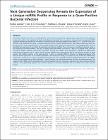| dc.contributor.author | O'FARRELLY, CLIONA | |
| dc.date.accessioned | 2013-07-09T14:36:57Z | |
| dc.date.available | 2013-07-09T14:36:57Z | |
| dc.date.issued | 2013 | |
| dc.date.submitted | 2013 | en |
| dc.identifier.citation | Lawless, N., Foroushani, A.B.K., McCabe, M.S., O'Farrelly, C., Lynn, D.J., Next Generation Sequencing Reveals the Expression of a Unique miRNA Profile in Response to a Gram-Positive Bacterial Infection, PLoS ONE, 8, 3, 2013, art. no. e57543 | en |
| dc.identifier.other | Y | |
| dc.identifier.uri | http://hdl.handle.net/2262/66673 | |
| dc.description | PUBLISHED | en |
| dc.description.abstract | MicroRNAs (miRNAs) are short, non-coding RNAs, which post-transcriptionally regulate gene expression and are proposed to play a key role in the regulation of innate and adaptive immunity. Here, we report a next generation sequencing (NGS) approach profiling the expression of miRNAs in primary bovine mammary epithelial cells (BMEs) at 1, 2, 4 and 6 hours post-infection with Streptococcus uberis, a causative agent of bovine mastitis. Analysing over 450 million sequencing reads, we found that 20% of the approximately 1,300 currently known bovine miRNAs are expressed in unchallenged BMEs. We also identified the expression of more than 20 potentially novel bovine miRNAs. There is, however, a significant dynamic range in the expression of known miRNAs. The top 10 highly expressed miRNAs account for >80% of all aligned reads, with the remaining miRNAs showing much lower expression. Twenty-one miRNAs were identified as significantly differentially expressed post-infection with S. uberis. Several of these miRNAs have characterised roles in the immune systems of other species. This miRNA response to the Gram-positive S. uberis is markedly different, however, to lipopolysaccharide (LPS) induced miRNA expression. Of 145 miRNAs identified in the literature as being LPS responsive, only 9 were also differentially expressed in response to S. uberis. Computational analysis has also revealed that the predicted target genes of miRNAs, which are down-regulated in BMEs following S. uberis infection, are statistically enriched for roles in innate immunity. This suggests that miRNAs, which potentially act as central regulators of gene expression responses to a Gram-positive bacterial infection, may significantly regulate the sentinel capacity of mammary epithelial cells to mobilise the innate immune system. | en |
| dc.description.sponsorship | This project was supported by Teagasc (RMIS 6018). NL and AF are supported by the Teagasc Walsh Fellowship Scheme. The funders had no role in
study design, data collection and analysis, decision to publish, or preparation of the manuscript | en |
| dc.format.extent | art. no. e57543 | en |
| dc.language.iso | en | en |
| dc.relation.ispartofseries | PLoS ONE; | |
| dc.relation.ispartofseries | 8; | |
| dc.relation.ispartofseries | 3; | |
| dc.rights | Y | en |
| dc.subject | animal cell; article; breast epithelium; controlled study; cow; down regulation; gene expression; gene expression profiling; Gram positive infection; high throughput sequencing; innate immunity; mathematical analysis; next generation sequencing; nonhuman; RNA isolation; sequence analysis; Streptococcus uberis | en |
| dc.subject.lcsh | animal cell; article; breast epithelium; controlled study; cow; down regulation; gene expression; gene expression profiling; Gram positive infection; high throughput sequencing; innate immunity; mathematical analysis; next generation sequencing; nonhuman; RNA isolation; sequence analysis; Streptococcus uberis | en |
| dc.title | Next Generation Sequencing Reveals the Expression of a Unique miRNA Profile in Response to a Gram-Positive Bacterial Infection | en |
| dc.type | Journal Article | en |
| dc.contributor.sponsor | Teagasc | en |
| dc.type.supercollection | scholarly_publications | en |
| dc.type.supercollection | refereed_publications | en |
| dc.identifier.peoplefinderurl | http://people.tcd.ie/ofarrecl | |
| dc.identifier.rssinternalid | 87035 | |




